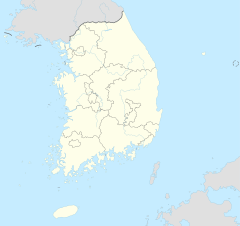Korea's provinces have been the primary administrative division of Korea since the mid Goryeo dynasty in the early 11th century, and were preceded by provincial-level divisions dating back to Unified Silla, in the late 7th century.

Gangneung is a municipal city in the province of Gangwon-do, on the east coast of South Korea. It has a population of 213,658. Gangneung is the economic centre of the Yeongdong region of Gangwon-do. Gangneung has many tourist attractions, such as Jeongdongjin, a very popular area for watching the sun rise, and Gyeongpo Beach. There is an ROKAF airbase south of downtown Gangneung that formerly doubled as a civil airport.
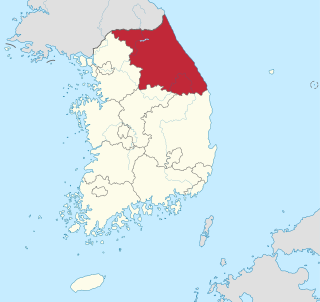
Gangwon Province is a province of South Korea, with its capital at Chuncheon. It is bounded on the east part by the Sea of Japan, and borders Gyeonggi Province to its west, and North Gyeongsang Province and North Chungcheong Province to its south. Its northern boundary is the Military Demarcation Line, separating it from North Korea's Kangwŏn Province. Before the division of Korea in 1945 Gangwon and Kangwŏn formed a single province. Pyeongchang County in Gangwon hosted the 2018 Winter Olympics and 2018 Winter Paralympics. Gangwon will host the 2024 Winter Youth Olympics.
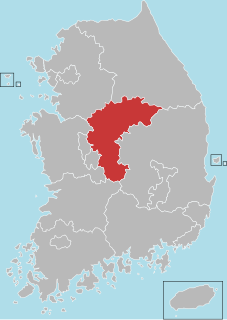
North Chungcheong Province, also known as Chungbuk, is a province of South Korea. North Chungcheong has a population of 1,578,934 (2014) and has a geographic area of 7,433 km2 located in the Hoseo region in the south-center of the Korean Peninsula. North Chungcheong borders the provinces of Gyeonggi and Gangwon to the north, North Gyeongsang to the east, North Jeolla to the south and South Chungcheong, Sejong Special Autonomous City and Daejeon Metropolitan City to the west.

Gyeongsang was one of the eight provinces of Korea during the Joseon dynasty. Gyeongsang was located in the southeast of Korea.

Donghae is a city in Gangwon Province, South Korea. There are two major ports: Donghae Harbor and Mukho Harbor. The city is located on the Yeongdong Line railroad and the Donghae Expressway. Numerous caverns are found in the city, as in neighboring Samcheok. Hanzhong University was located here.
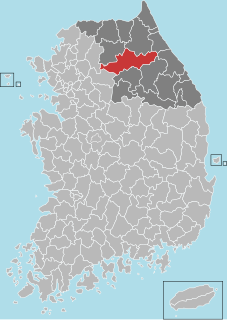
Hongcheon (Hongcheon-gun) is a county and city in Gangwon Province, South Korea. The city lies on the northern bank of the Hongcheon River, southeast of Chuncheon. The terrain of the county is mainly mountainous and contains hot springs in the Hongcheong River valley. The county produces ginseng, maize, and vegetables. As of 2012 the county had a population of 70,401 people in 29,894 households.
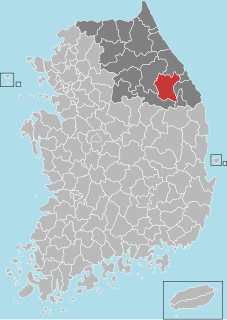
Jeongseon (Jeongseon-gun) is a county in the province of Gangwon-do, South Korea. It is famous as the hometown of "Jeongseon Arirang," a traditional Korean folksong. It is also the hometown of actor Won Bin and footballer Seol Ki-hyeon.

Pyeongchang is a county in the province of Gangwon-do, South Korea, located in the Taebaek Mountains region. It is home to several Buddhist temples, including Woljeongsa. It is about 180 km (110 mi) east southeast of Seoul, the capital of South Korea, and connected by expressways and high-speed passenger railways. Pyeongchang's slogan, "Happy 700 Pyeongchang", is taken from its average elevation of approximately 700 metres (2,300 ft).

The Taebaek Mountains are a mountain range that stretches across North Korea and South Korea. They form the main ridge of the Korean peninsula.

Sokcho is a city in Gangwon-do province, South Korea. It is located in the far northeast of Gangwon-do. The city is a major tourist hub, and a popular gateway to nearby Seoraksan national park. Sokcho is home to the few lakes: Yeongrangho and Cheongchoho that are naturally created by the Sea of Japan.
Gwandong is a region coinciding with the former Gangwon Province in Korea. Today, the term refers to South Korea's Gangwon Province and North Korea's Kangwon Province. The name is often used to refer to people residing in the region.

The Yeongdong Line is a line of Korail. It connects Yeongju in North Gyeongsang Province with Gangneung in Gangwon Province. From Yeongju, it crosses the Taebaek Mountains and reaches the Sea of Japan at Donghae, thence proceeding north to Gangneung.
Gangwon or Kangwŏn may refer to:

Woljeongsa is a head temple of the Jogye Order of Korean Buddhism, located on the eastern slopes of Odaesan in Pyeongchang County, Gangwon Province, South Korea. Woljeongsa was founded in 643 by the Silla monk Jajang.

Gangwon Province or Gangwon-do was one of the Eight Provinces of Korea during the Joseon Dynasty. The province was formed in 1395, and derived its name from the names of the principal cities of Gangneung and the provincial capital Wonju.
This is a partial list of Korea-related topics beginning with G. For Korean words starting with ㄱ, see also under K.

Gangwon FC is a South Korean football club. Based in Gangwon Province of South Korea, Gangwon FC joined the K League as its 15th club for the 2009 season. The club is sponsored by High1 Resort.
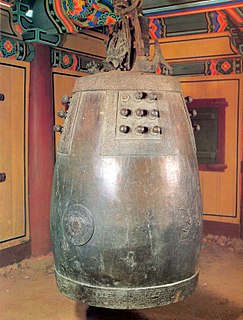
The Bell of Sangwonsa is a bronze bell designated as National Treasures of South Korea #36. It is located in the Sangwonsa temple in Pyeongchang County, Gangwon Province.

